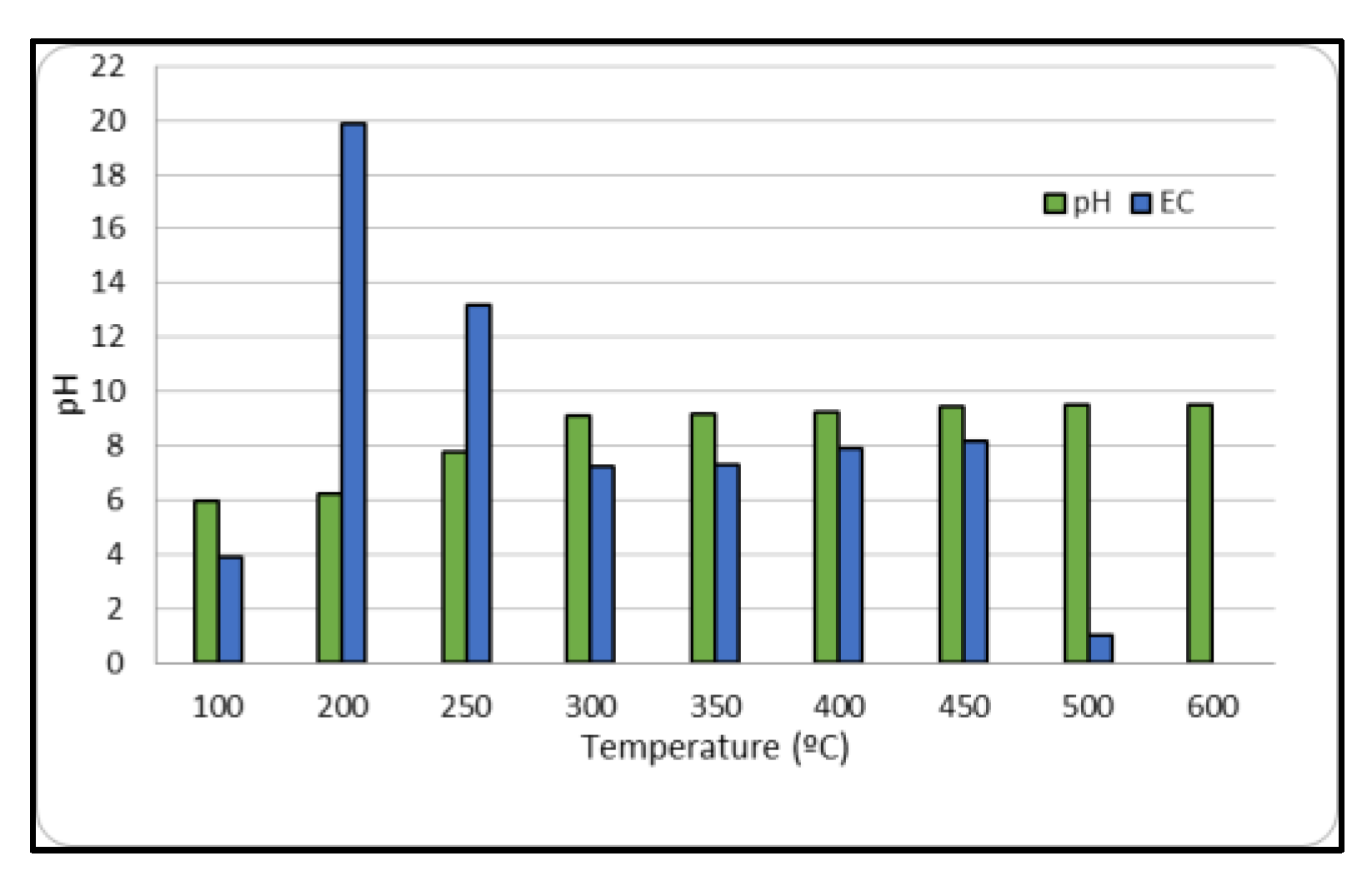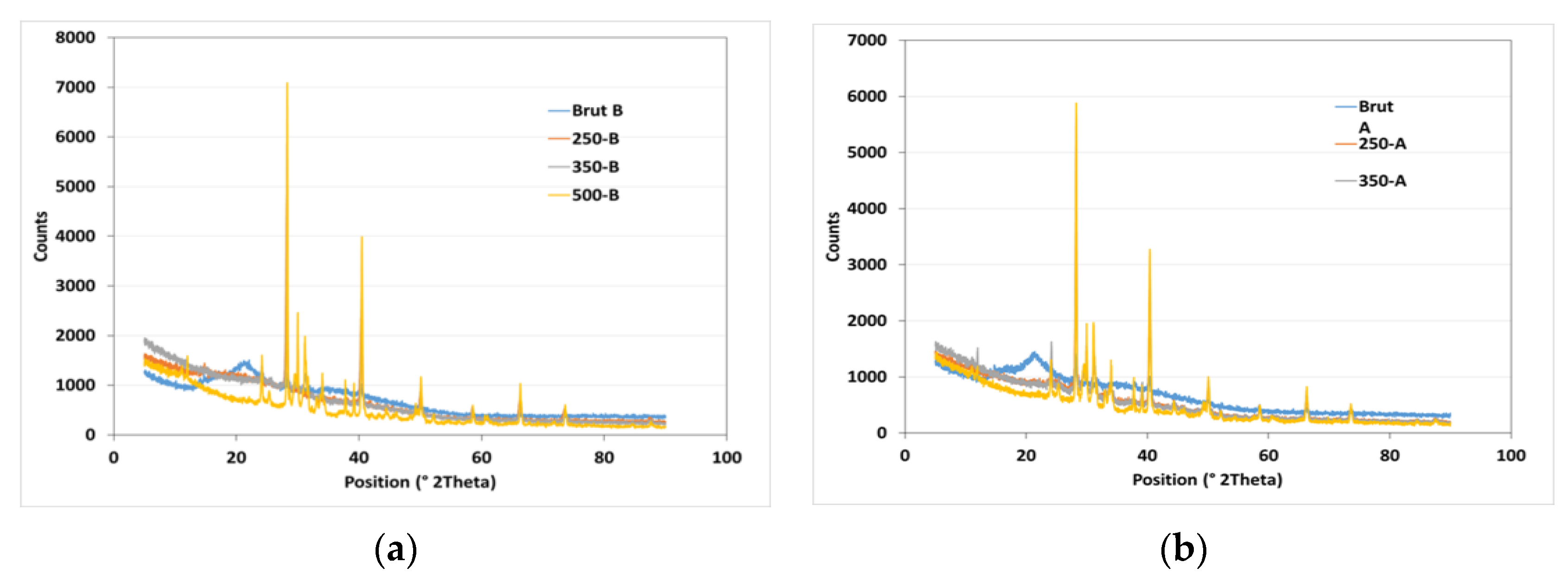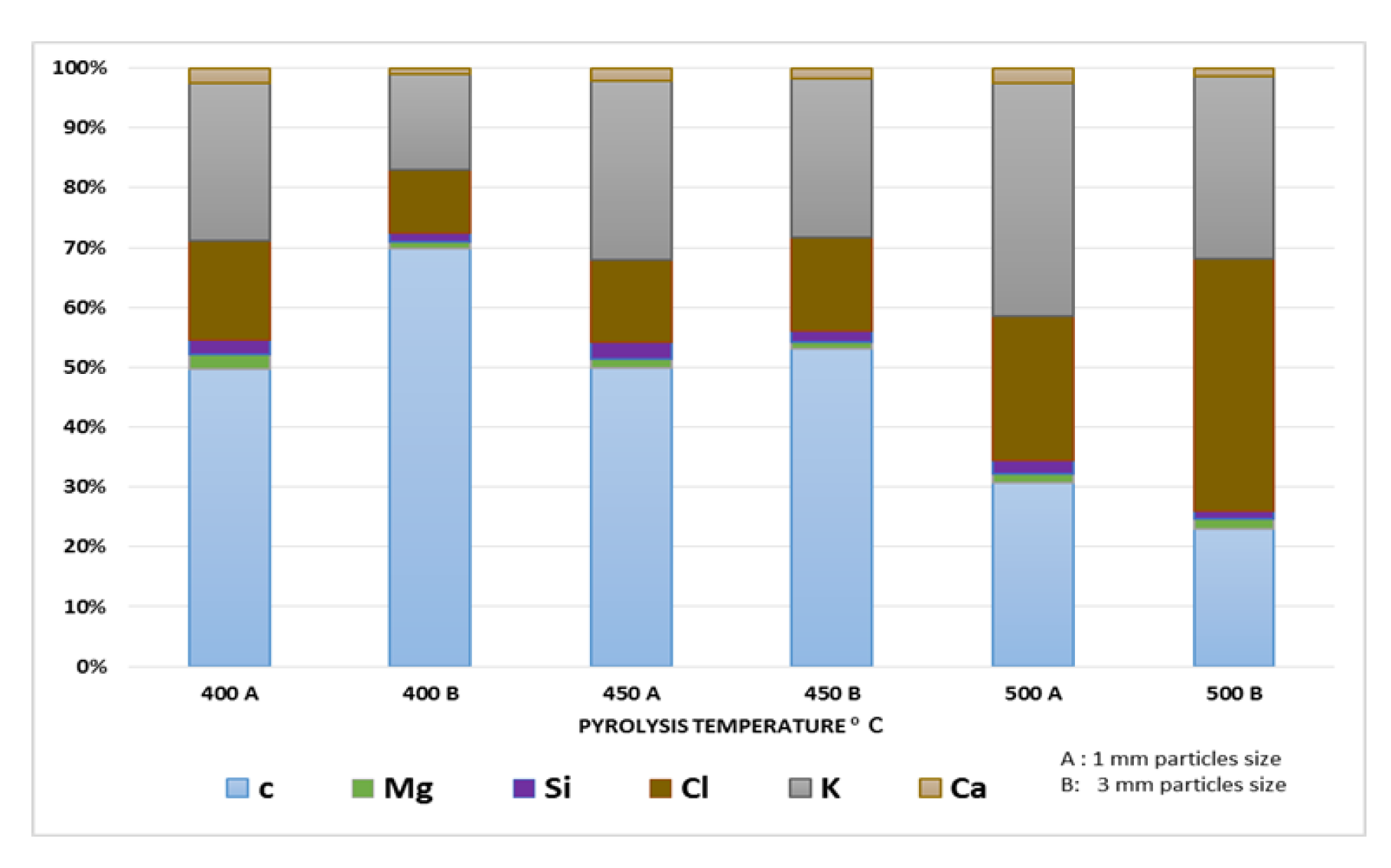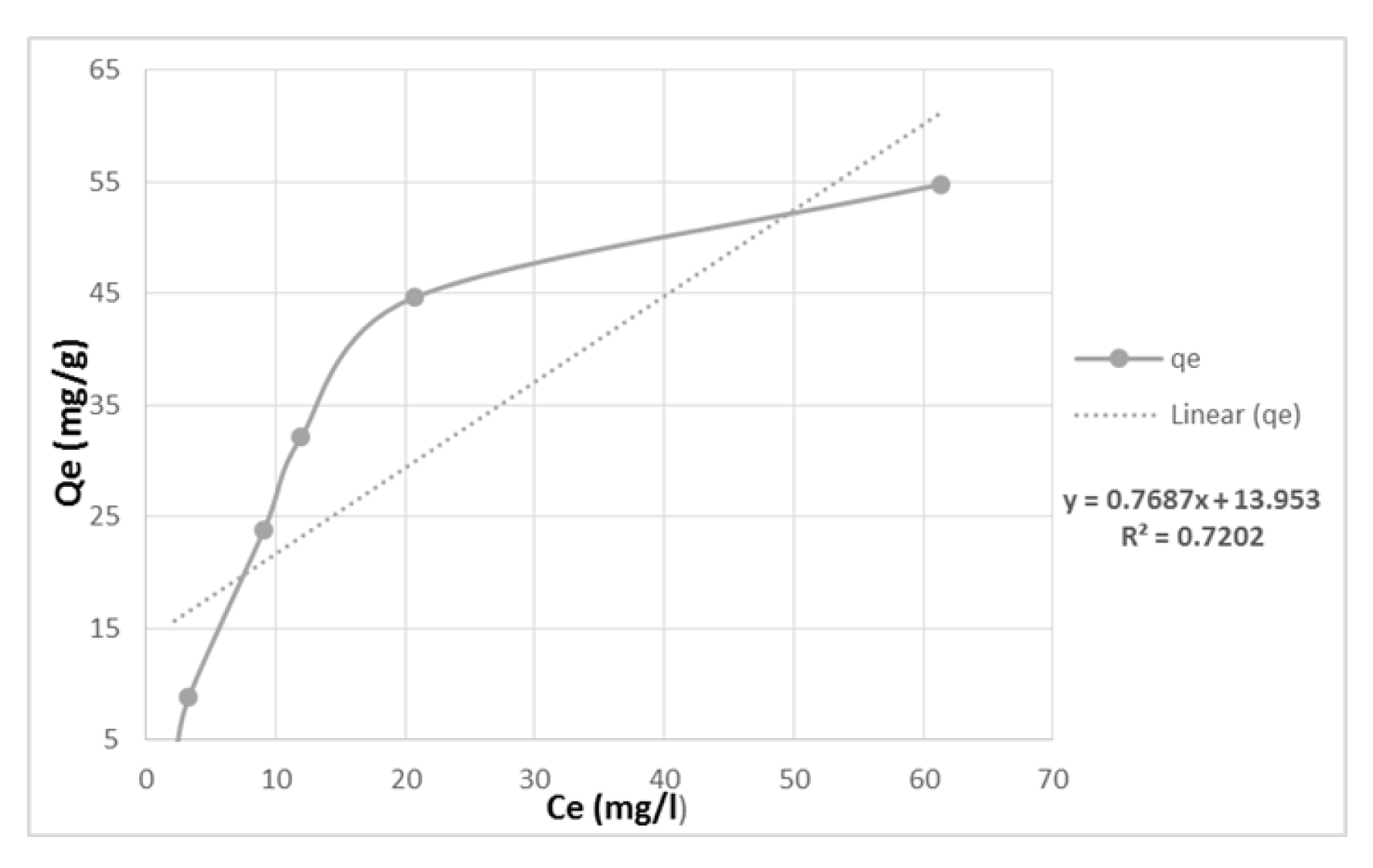Characterization and Environmental Application Potential of Banana Peels Biochar †
Abstract
:1. Introduction
2. Materials and Methods
2.1. Biochar Preparation
2.2. Biochar Characterization
2.3. Adsorption Experiment
3. Results
3.1. Biochar Yield
3.2. Ash Content
3.3. pH and Electrical Conductivity
3.4. X-ray Diffraction (XRD)
3.5. Scanning Electron Microscopy (SEM)
3.6. X-ray Fluorescence (XRF) Analysis
3.7. Copper Adsorption
4. Conclusions
Author Contributions
Funding
Institutional Review Board Statement
Informed Consent Statement
Data Availability Statement
Conflicts of Interest
References
- Sweep-Net. Country Report on the Solid Waste Management in Lebanon; Deutsche Gesellschaft für Internationale Zusammenarbeit (GIZ): Bonn, Germany, 2014. [Google Scholar]
- Abbas, I.I.; Chaaban, J.K.; Al-Rabaa, A.R.; Shaar, A.A. Solid waste management in Lebanon: Challenges and recommendations. Environ. Sci. Pollut. Res. Int. 2017, 24, 8654–8664. [Google Scholar]
- Human Rights Watch. Lebanon: Huge Cost of Inaction on Trash Crisis. 2020. Available online: https://www.hrw.org/news/2020/06/09/lebanon-huge-cost-inaction-trash-crisis (accessed on 12 June 2020).
- Alam, P.; Ahmade, K. Impact of solid waste on health and the environment. J. Educ. Pract. 2013, 2, 23–29. [Google Scholar]
- Kabenge, I.; Omulo, G.; Banadda, N.; Seay, J.; Zziwa, A.; Kiggundu, N. Characterization of banana peel wastes as potential slow pyrolysis feedstock. J. Sustain. Dev. 2018, 11, 14. [Google Scholar] [CrossRef]
- Pathak, P.D.; Mandavgane, S.A.; Kulkarni, B.D. Fruit Peel Waste: Characterization and Its Potential Uses. Curr. Sci. 2017, 113, 444. [Google Scholar] [CrossRef]
- Zhou, N.; Chen, H.; Xi, J.; Yao, D.; Zhou, Z.; Tian, Y.; Lu, X. Biochars with excellent Pb(II) adsorption property produced from fresh and dehydrated banana peels via hydrothermal carbonization. Bioresour. Technol. 2017, 232, 204–210. [Google Scholar] [CrossRef] [PubMed]
- Zeng, H.; Qi, W.; Zhai, L.; Wang, F.; Zhang, J.; Li, D. Magnetic biochar is synthesized with waterworks sludge and sewage sludge and its potential for removing methylene blue. J. Environ. Chem. Eng. 2021, 9, 105951. [Google Scholar] [CrossRef]
- Hu, X.; Zhang, R.; Xia, B.; Ying, R.; Hu, Z.; Tao, X.; Yu, H.; Xiao, F.; Chu, Q.; Chen, H.; et al. Effect of Pyrolysis Temperature on Removal Efficiency and Mechanisms of Hg(II), Cd(II), and Pb(II) by Maize Straw Biochar. Sustainability 2022, 14, 9022. [Google Scholar] [CrossRef]
- Zhang, J.; Liu, J.; Liu, R. Effects of pyrolysis temperature and heating time on biochar obtained from the pyrolysis of straw and lignosulfonate. Bioresour. Technol. 2015, 176, 288–291. [Google Scholar] [CrossRef] [PubMed]
- Islam, M.U.; Jiang, F.; Guo, Z.; Peng, X. Does biochar application improve soil aggregation? A meta-analysis. Soil Tillage Res. 2021, 209, 104926. [Google Scholar] [CrossRef]
- Feitosa, A.A.; Teixeira, W.G.; Ritter, E.; Resende FA, D.; Kern, J. Characterization of biochar samples of banana peels and orange bagasse carbonized at 400 and 600 °C. Rev. Virtual Quim. 2020, 12, 901–912. [Google Scholar]
- Nasreddine, L.; Rehaime, M.; Kassaify, Z.; Rechmany, R.; Jaber, F. Dietary exposure to pesticide residues from foods of plant origin and drinks in Lebanon. Environ. Monit. Assess. 2016, 188, 485. [Google Scholar] [CrossRef] [PubMed]






| Freundlich Model | Langmuir Model | ||
|---|---|---|---|
| n | 5.31 | Qm | 1.47 |
| kf | 2.7 | k | −32.38 |
| R2 | 0.86 | R2 | 0.88 |
Disclaimer/Publisher’s Note: The statements, opinions and data contained in all publications are solely those of the individual author(s) and contributor(s) and not of MDPI and/or the editor(s). MDPI and/or the editor(s) disclaim responsibility for any injury to people or property resulting from any ideas, methods, instructions or products referred to in the content. |
© 2023 by the authors. Licensee MDPI, Basel, Switzerland. This article is an open access article distributed under the terms and conditions of the Creative Commons Attribution (CC BY) license (https://creativecommons.org/licenses/by/4.0/).
Share and Cite
Kataya, G.; Issa, M.; Jeguirim, M.; Hijazi, A. Characterization and Environmental Application Potential of Banana Peels Biochar. Eng. Proc. 2023, 37, 105. https://doi.org/10.3390/ECP2023-14725
Kataya G, Issa M, Jeguirim M, Hijazi A. Characterization and Environmental Application Potential of Banana Peels Biochar. Engineering Proceedings. 2023; 37(1):105. https://doi.org/10.3390/ECP2023-14725
Chicago/Turabian StyleKataya, Ghenwa, May Issa, Mejdi Jeguirim, and Akram Hijazi. 2023. "Characterization and Environmental Application Potential of Banana Peels Biochar" Engineering Proceedings 37, no. 1: 105. https://doi.org/10.3390/ECP2023-14725
APA StyleKataya, G., Issa, M., Jeguirim, M., & Hijazi, A. (2023). Characterization and Environmental Application Potential of Banana Peels Biochar. Engineering Proceedings, 37(1), 105. https://doi.org/10.3390/ECP2023-14725







